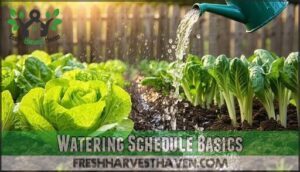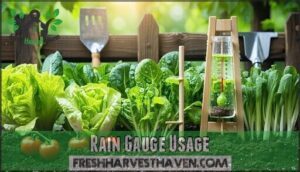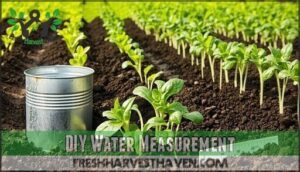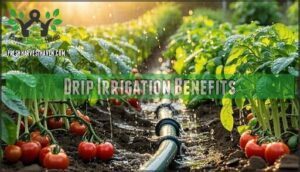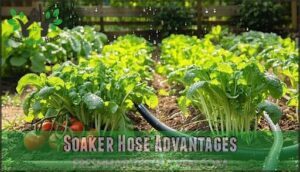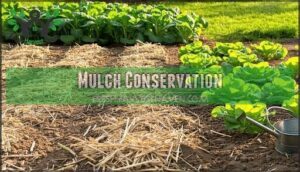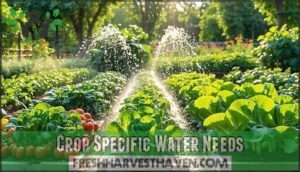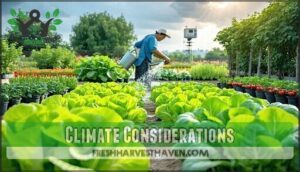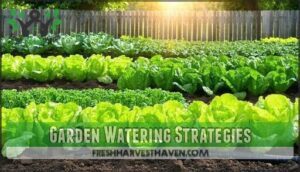This site is supported by our readers. We may earn a commission, at no cost to you, if you purchase through links.
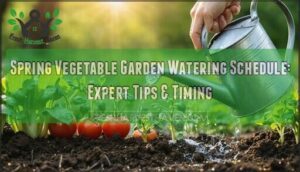
Water deeply once or twice weekly, providing about 1-2 inches total.
Sandy soils drain quickly and need watering twice weekly, while clay or loamy soils hold moisture longer and require once-weekly watering.
Water early morning to reduce evaporation and prevent disease.
Check soil moisture by inserting your finger 2-3 inches deep – if it’s dry, it’s time to water.
Consistent moisture is key for healthy vegetables, but avoid overwatering which can cause root rot and other problems.
Table Of Contents
Key Takeaways
- Water deeply 1-2 times weekly – Provide 1-1.5 inches total per week, adjusting frequency based on your soil type (sandy soils need watering twice weekly, clay soils once weekly).
- Water early morning for best results – You’ll reduce evaporation by 30% and prevent fungal diseases while allowing foliage to dry before evening.
- Check soil moisture before watering – Insert your finger 2-3 inches deep; if it’s dry, it’s time to water, preventing both drought stress and overwatering damage.
- Use efficient watering methods – Drip irrigation or soaker hoses deliver water directly to roots, reducing water usage by 60% while keeping foliage dry and healthy.
Soil Preparation Matters
You’ll get better results if you start with healthy soil, since organic matter like compost helps your garden hold water and resist disease.
Test your soil and add compost each season to improve structure and boost nutrients for spring crops.
Organic Matter Importance
When you enrich your soil with organic matter like compost, you’re building the foundation for spring garden watering success.
This amendment transforms soil structure, creating spaces that hold moisture while allowing proper drainage.
Enhanced nutrient availability feeds your plants efficiently, while improved water retention means less frequent irrigation.
Organic matter also promotes disease suppression and stronger root growth, making your vegetable garden irrigation schedule more effective and sustainable.
Compost Application Rates
With proper compost depth and application frequency, you’ll create the foundation for effective spring garden watering.
Apply one inch of plant-based compost annually, working it into the top six inches of soil.
Transform your garden’s foundation—one inch of compost annually creates the perfect canvas for thriving spring vegetables.
Soil testing determines if you need nutrient-rich manure composts at half-inch rates.
Many community gardens already have excessive phosphorus levels, so testing is essential.
- Plant-based compost: Apply up to 1 inch yearly for ideal nutrient availability without salt buildup
- Manure-based compost: Limit to 0.5 inch annually to prevent excessive phosphorus and crop impact
- Soil testing: Check nutrient levels before application to avoid over-fertilization in your vegetable garden irrigation system
Watering Schedule Basics
You’ll need to establish a consistent watering routine that delivers the right amount of moisture at ideal times.
Spring vegetable gardens require 1-1.5 inches of water per week from rainfall or irrigation, with early morning watering reducing evaporation rates by 30% compared to midday sessions.
Weekly Water Needs
Your spring vegetable garden watering guide starts with understanding weekly water requirements. Most vegetables need approximately one inch of water per week through rainfall or irrigation.
This watering frequency vegetables depends on soil moisture levels and climate-specific adjustments. Sandy soils require more frequent applications, while clay retains moisture longer.
Monitor your watering schedule spring carefully, as overwatering risks can damage root systems and reduce yields substantially. Using drip irrigation systems can help prevent this.
Morning Watering Benefits
Watering your spring vegetable garden in the morning delivers the best time water garden results.
Early hydration promotes root health while allowing complete foliage drying before evening. This timing prevents fungal diseases and guarantees consistent hydration throughout the day.
Morning watering techniques spring into action with evaporation reduction benefits, making your watering schedule spring-ready and efficient, which is a key part of a successful watering schedule.
Avoiding Midday Watering
Nobody wants to water their garden when the sun’s blazing overhead.
Midday watering creates massive water waste through evaporation, leaving your plants thirsty despite your efforts.
The best time to water your garden is early morning, allowing foliage drying before evening.
This watering schedule prevents sun scald and promotes root health while your watering techniques spring into action efficiently.
Measuring Water Depth
Measuring your garden’s water intake accurately guarantees your spring vegetables receive proper hydration without waste.
You’ll need simple tools like rain gauges or homemade containers to track whether you’re hitting that vital one-inch weekly target.
Rain Gauge Usage
Rain gauges provide accurate measurement of weekly precipitation, helping you determine if your garden needs supplemental watering. Strategic placement matters for reliable data interpretation.
Position gauges away from structures and vegetation that might block rainfall. Here’s how to optimize rain gauge usage:
- Mount at ground level in open areas
- Check weekly for precise depth monitoring
- Record measurements to track watering schedule patterns
This data helps maintain proper soil moisture levels and adjust watering frequency based on natural rainfall. To prevent overwatering, understanding plant specific watering is key to a healthy garden, ensuring the right amount of watering for your plants.
DIY Water Measurement
Beyond expensive gadgets, simple household items create effective water measurement techniques.
Place straight-sided tuna cans flush with soil surface for accurate water application monitoring.
Mark rulers inside containers for instant depth readings.
Your homemade rain-gauge system tracks irrigation consistency better than guesswork.
Container calibration guarantees water depth consistency across garden beds.
These DIY methods help maintain proper soil moisture levels without breaking the bank.
These systems can also simplify plant care by providing consistent watering schedules for effective water measurement and proper irrigation, ensuring a well-maintained garden with consistent watering and accurate water application.
Soil Moisture Checks
Before diving into soil moisture checks, master these simple techniques to gauge when your garden needs water.
Your finger becomes the most reliable tool for determining soil moisture levels.
- Feel Test: Push your finger 1-2 inches into soil depth – dry soil crumbles while moist soil holds together
- Ball Test: Squeeze soil in your palm – if it forms a ball, moisture is adequate; if it reaches the crumble point, water immediately
- Wilting Signs: Check plants for temporary midday drooping versus persistent wilting indicating soil dryness
Regular soil moisture checks prevent both drought stress and soil saturation, ensuring ideal soil level watering for healthy spring vegetables.
Efficient Watering Techniques
You’ll save water and grow healthier vegetables by choosing the right watering method for your spring garden.
The three most effective techniques – drip irrigation, soaker hoses, and mulching – work together to deliver moisture directly where plants need it most.
Drip Irrigation Benefits
Drip irrigation delivers water directly to your vegetable roots, maximizing efficiency while minimizing waste.
This targeted approach reduces water usage by 60% compared to overhead sprinklers while promoting healthy root development and preventing leaf diseases.
Consider using a complete irrigation setup for ideal results.
| Benefit | Impact | Result |
|---|---|---|
| Water Conservation | 60% reduction in usage | Lower utility bills |
| Disease Prevention | Dry foliage maintained | Healthier plants |
| Root Zone Water Delivery | Direct soil saturation | Stronger root systems |
| Uniform Growth | Consistent moisture levels | Even plant development |
Soaker Hose Advantages
Soaker hoses deliver water directly to plant roots, creating even moisture distribution throughout your garden beds.
This targeted delivery method reduces surface runoff by 25% compared to overhead sprinklers. You’ll conserve water while preventing disease by keeping foliage dry.
Consider the various soaker hose options available for your garden.
The gentle, consistent flow makes soaker hoses perfect for watering vegetables that need steady hydration without leaf wetness, providing even moisture distribution and using targeted delivery.
Mulch Conservation
Mulching creates a protective barrier that slashes water loss by 40% through evaporative moisture reduction.
Apply organic mulch like straw or wood chips 2-3 inches deep around plants, keeping it away from stems.
This soil cooling technique cuts watering frequency while suppressing weeds.
Mulch alternatives include grass clippings or shredded leaves for effective water conservation.
Crop Specific Water Needs
Understanding your vegetables’ specific water needs helps you create an efficient watering schedule that promotes healthy growth.
Each crop type has unique requirements based on its root system, leaf structure, and growth stage, which is crucial for creating an efficient watering schedule that supports efficient growth.
Leafy Greens Requirements
Consistency makes the difference between thriving leafy greens and disappointing harvests.
These tender crops need steady soil moisture for ideal nutrient uptake and disease prevention.
- Watering frequency: Provide 1-1.5 inches weekly through light, frequent sessions every 2-3 days
- Growth stages: Maintain 60-80% soil moisture during early stage watering to encourage strong foliage
- Small roots prevention: Check soil 2 inches deep to avoid overwatering that stunts development
Root Vegetables Needs
Root vegetables like carrots and beets need 1-2 inches of water weekly for ideal root development.
Deep watering twice weekly encourages robust root growth and better nutrient uptake than frequent shallow sessions.
Maintain soil moisture at 70% field capacity to prevent cracking from uneven watering.
Proper watering depth reaches 6-8 inches, promoting deep root penetration and maximizing yield optimization for your vegetable water needs.
Fruit Bearing Crops
Growing fruit-bearing crops like tomatoes, peppers, and squash requires strategic watering during critical watering times.
These vegetables demand up to 2 inches weekly during fruit formation and development stages.
Consistent moisture prevents blossom end rot and optimizes yield through proper pollination needs support.
- Deep watering twice weekly encourages stronger root systems for heavy fruit production
- Drip irrigation increases squash yields by 18% through steady root zone moisture delivery
- Water stress during flowering reduces cucumber and squash yields by 22%
- Inconsistent watering causes blossom end rot in 15% of tomato crops annually
Climate Considerations
Your spring garden’s water needs change dramatically with weather conditions. Temperature swings, wind patterns, and heat waves require you to adjust your watering schedule beyond the basic one-inch-per-week rule.
Temperature Effects
Temperature directly affects your spring vegetable watering schedule through increased evaporation rates and heat stress on plants.
For every 10°F above 60°F, add ½ inch of water weekly to prevent wilting and maintain healthy growth in different climate zones.
Protecting plants from unexpected temperature drops can be vital, and mulch offers insulation for sensitive roots.
| Temperature Range | Weekly Water Need | Seasonal Adjustments |
|---|---|---|
| 60-70°F | 1 inch | Standard spring care |
| 71-80°F | 1.5 inches | Monitor heat stress |
| 81°F+ | 2+ inches | Daily moisture checks |
Growing degree-days help determine when temperature effects require watering tips modifications.
Weather conditions fluctuate during spring, so adjust your schedule based on current temperature effects rather than calendar dates alone, considering temperature effects and current temperature.
Windy Conditions Impact
When wind sweeps across your garden, it creates a perfect storm for water loss.
Windy conditions accelerate evaporation rates by up to 50%, leaving your plants thirsting for more frequent watering sessions.
- Increase watering frequency from weekly to every 2-3 days during windy periods
- Apply thicker mulch layers (3-4 inches) to shield soil from wind exposure
- Install temporary windbreaks using row covers or screens around vulnerable crops
- Monitor soil moisture daily by checking 2 inches below surface level
- Water earlier in morning to maximize absorption before wind picks up
Hot Weather Adjustments
During hot weather, your garden demands increased attention to prevent evaporation increase and wilting prevention.
When temperature thresholds exceed 75°F, adjust watering frequency to match crop sensitivity needs.
| Temperature Range | Water Adjustment |
|---|---|
| 60-70°F | Standard 1 inch weekly |
| 70-80°F | Add 0.5 inches weekly |
| 80-90°F | Add 1 inch weekly |
| Above 90°F | Add 1.5 inches weekly |
Monitor water quantity daily during dry weather watering periods to maintain ideal soil moisture levels and prevent wilting by ensuring the right water adjustment.
Garden Watering Strategies
Smart watering strategies can transform your spring garden from surviving to thriving with minimal effort on your part.
You’ll discover how automated timers, rainwater collection, and understanding your garden’s unique microclimate can save both time and water while boosting your harvest.
Automated Timers
Automated watering timers deliver Timer Benefits by maintaining Schedule Consistency without daily oversight.
These irrigation systems increase plant health markers in ninety percent of monitored beds while achieving significant Water Savings.
Modern watering timers offer System Integration with drip irrigation vegetables setups and Remote Control capabilities.
You’ll find drip system schedules work perfectly with automated timers for reliable moisture delivery.
Rainwater Harvesting
Smart water collection transforms garden irrigation into a sustainable practice. Rainwater harvesting supplies up to 35% of spring garden irrigation needs in temperate zones.
Collection methods and storage solutions reduce your dependency on municipal water while providing cost savings.
- Rain barrels positioned under downspouts capture roof runoff efficiently
- Filtration systems remove debris while maintaining water quality standards
- First-flush diverters redirect initial contaminated water away from storage
- Gravity-fed distribution systems deliver collected water through garden hoses
This water conservation technique offers pure rainfall watering that plants prefer over treated municipal water. Your watering techniques become more sustainable while reducing monthly bills through effective water collection strategies, which is a key part of water conservation and leads to effective water collection.
Microclimate Considerations
Your garden’s unique microclimates dramatically affect watering needs.
Shaded areas retain moisture 40% longer than sunny spots, while wind barriers reduce evaporation by half.
Check soil moisture in frost pockets and observe how local topography creates humidity variations.
Adjust your watering techniques accordingly – plants near south-facing walls need extra water, while sheltered corners require less frequent irrigation to thrive in their specific microclimates.
Frequently Asked Questions (FAQs)
How often should I water my garden in spring?
Spring gardens need 30% less water than summer crops. Water your spring vegetable garden 1-5 inches weekly through deep, infrequent sessions every 2-3 days, adjusting for soil type and weather conditions.
How often should I fertilize spring vegetables?
Fertilize your spring vegetables every 3-4 weeks with balanced fertilizer. Apply compost or organic amendments at planting, then side-dress with nitrogen-rich fertilizer when plants are actively growing for maximum yields.
What are signs of overwatering in gardens?
Are your plants drowning instead of thriving? Look for yellowing leaves, musty soil odors, and fungal growth. Overwatered plants develop soft, blackened roots and wilted foliage despite moist soil conditions.
Should I water during light spring rain?
Yes, you should water during light spring rain. This timing helps water penetrate deeper into the soil rather than just wetting the surface, ensuring your plants get thorough hydration.
How deep should irrigation water penetrate soil?
Water should penetrate 6-12 inches deep to encourage strong root development.
You’ll achieve this by watering slowly and deeply rather than frequent shallow sessions, ensuring roots grow downward for drought resistance.
Can I use greywater for vegetable gardens?
Surprisingly, you’re already using greywater if you’ve reused pasta water.
You can safely use greywater from sinks, showers, and laundry for vegetables, but avoid water contaminated with harsh chemicals or soap.
Conclusion
Research shows that properly watered vegetable gardens produce 40% more yield than inconsistently watered ones.
Your spring vegetable garden watering schedule success depends on consistent monitoring and adjustment.
Remember to check soil moisture regularly, water deeply but infrequently, and adapt your schedule to weather changes.
Early morning watering remains ideal for plant health and water conservation.
With proper timing and techniques, you’ll maximize your garden’s productivity while conserving water resources throughout the growing season, and achieve proper timing.
- https://cals.cornell.edu/field-crops/small-grains/diseases-small-grains/foliar-diseases
- https://sfyl.ifas.ufl.edu/find-your-local-office/
- https://extension.umn.edu/yard-and-garden-news/how-much-compost-should-you-apply-your-garden-spring
- https://go.illinois.edu/compostusage
- https://extension.usu.edu/yardandgarden/research/sustainable-manure-and-compost-application


